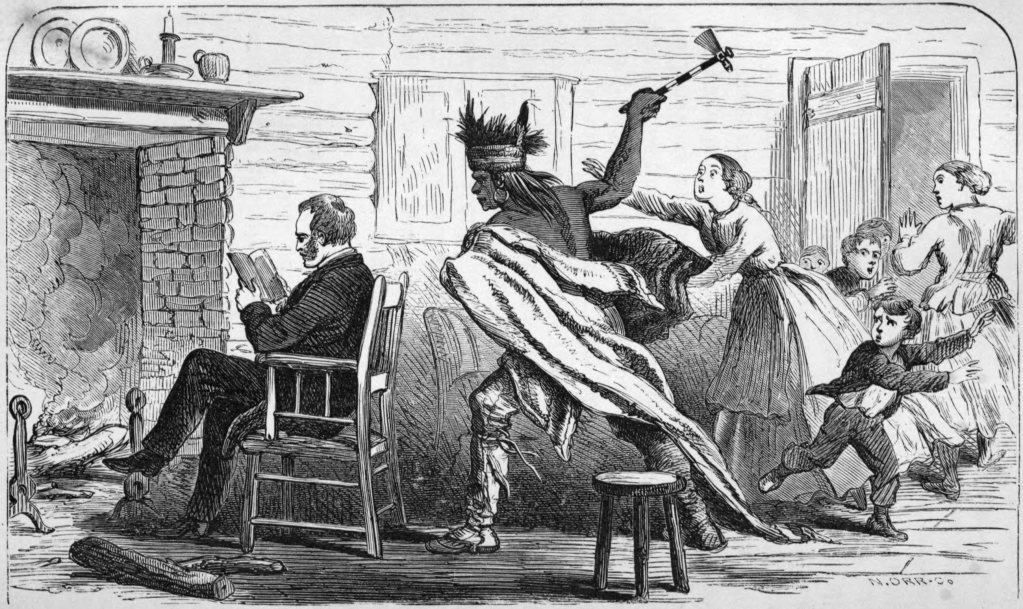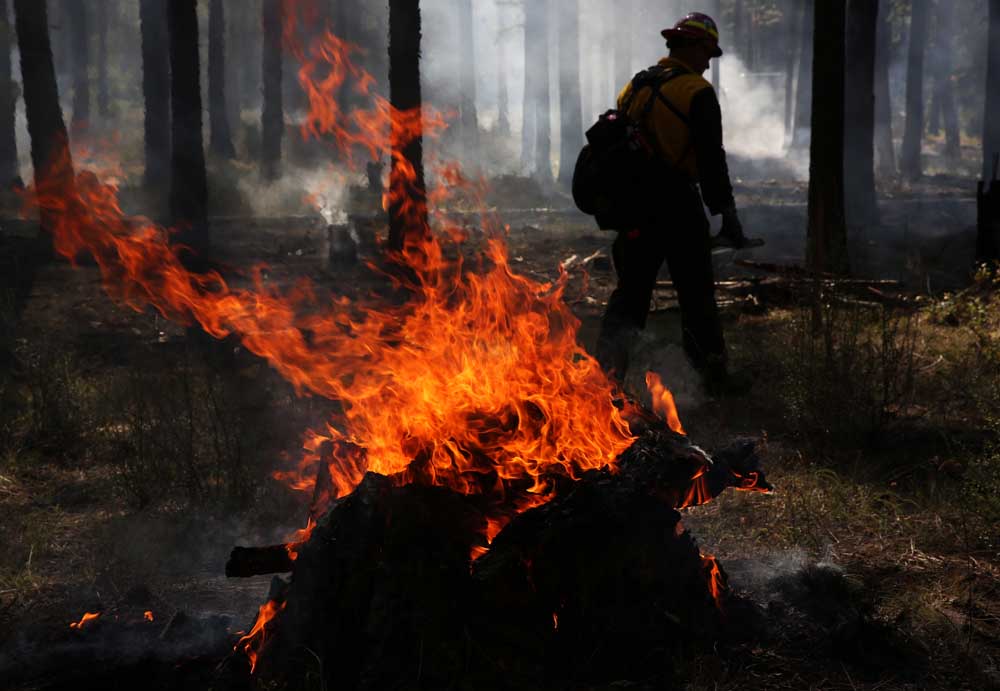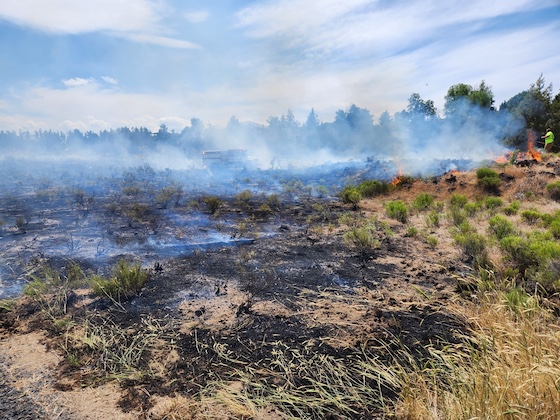Offbeat Oregon: The martyrdom of Marcus Whitman
Published 4:00 am Tuesday, March 19, 2024

- An illustration by Nathaniel Orr depicting the Whitman Massacre published in Frances Fuller Victor’s biography of Joseph Meek, published in 1877.
Just about everybody remembers the story of Paul Revere’s midnight ride. And most people have since learned that his ride was a bit less dramatic than was portrayed in the famous poem about it. Christopher Columbus is an even more egregious example of how modern myth-makers have shaped even truly unsavory historical characters for propaganda purposes.
The Oregon Territory’s late, lamented missionaries Marcus and Narcissa Whitman were certainly not unsavory characters like Columbus.
But they had something more powerful going for them: Martyrdom. Or at least, something that looked a lot like it.
The Whitmans were killed in an 1847 Indian attack on their mission near Walla Walla. Afterward, there was a rush by various interested parties eager to construct self-serving myths made of roughly equal parts truths, speculations, and straight-up lies starring Marcus and Narcissa Whitman.
The result was that over the past century and a half the Whitmans have been credited and/or blamed for a dizzying array of stuff: The opening of the Oregon Trail itself; the fact that the U.S. rather than Great Britain ended up with full title to the Oregon Territory; the rise of “Manifest Destiny” as a motivating belief on the frontier; and even America’s loss of rights to a cod fishery off Newfoundland.
Their martyrdom has also been used, throughout the years, as “evidence” of a moral superiority of “white civilization,” to justify seizing Indian lands and exiling their former occupants to strange, faraway reservations.
It was pressed into the service of anti-Catholicism when a creative, psychotic Calvinist preacher fabricated a very wicked plot by “Papists” (a slur for Catholics) to encourage the Indians to attack Protestant settlers. And, it’s only fair to add, that it was used to save one of the finest small colleges in the Northwest from certain bankruptcy.
For good and ill, the Whitmans’ impact on the world after they died has utterly dwarfed what they were able to accomplish while they were alive. And because those impacts involved both winners and losers, the subject of the Whitman Mission and the Whitman Massacre is still a charged one even today, and the facts can be hard to separate from the wishful thinking and mythologizing that has been done over the years.
The Whitmans
Marcus and Narcisssa Whitman were a missionary couple who came out to the Oregon Country in 1836, nearly a decade before the Oregon Trail became a thing. They were part of a push of evangelical organizations sending missionaries out West to bring the word of God to the “heathens” there. Jason Lee was another.
These missionaries left the East Coast with the best of intentions — there is no reason to doubt that. They believed they’d been called by God to bring the Good News to the “savages.” To answer that call, they had to leave a comfortable place where they were respected professionals and plunge into a strange, faraway wilderness long before anyone had any reason to suspect doing so would lead to wealth or power.
Once the missionaries got to the new country, though, many of them did end up being corrupted — or at least distracted — by the opportunities that fell into their laps. The bitter writings of Margaret Jewett Bailey, who came to Oregon with the Jason Lee mission, are “Exhibit A.” Jewett Bailey describes a process of missionaries losing their enthusiasm for the ministry and instead filing land claims on the best plots, founding cities, and increasingly ignoring the Indians to shift their ministry to the white settlers who soon started arriving.
The Whitmans never were corrupted in this way, or at least not to the extent that others were. They were massacred before they had a chance to.
Yes, massacred, not “murdered.” Murder is a legal term for a criminal act. And the killings at the mission were technically not criminal acts — they took place inside the Cayuse nation’s boundaries and were not violations of Cayuse law. The attack was, however, a bad mistake by those who had ordered it. It was an international incident that led to a short and very unpleasant war that would all but destroy the tribe.
Keeping up with the Whitmans
Marcus and Narcissa Whitman were newlyweds, essentially honeymooning in the mission field. When they packed their traveling kit for the journey from upstate New York’s “burned-over district” to the wild and untamed West, they were accompanied by several other missionaries, including a couple named Henry and Eliza Spalding.
Reading between the lines of the historical record, one is left with the impression that if all the brains of the party were added together, at least 75 percent of the total would have been in the head of Eliza Spalding. Her husband turned out to be a serious liability for the group.
That was because Henry Spalding, before he knew Eliza and before Narcissa met Marcus, had asked Narcissa to marry him and been turned down flat. Henry Spalding, who (as we shall soon see) could hold a grudge longer and tighter than Scrooge McDuck could squeeze a nickel, never got over the rejection.
That must have made for some extraordinarily awkward moments on the journey to Oregon Country. Awkward, and probably baffling for poor Marcus, who obviously was unaware of his wife’s pre-marital history with the man he thought of, at least at first, as his top lieutenant.
Spalding’s constant sniping at Marcus seems to have set a tone which some of the other missionaries also responded and contributed to. As soon as they arrived at the mission site, and well into the early 1840s, the bunch of them were far too busy feuding with each other to do much missionary outreach.
What little outreach they did do was demoralizingly unproductive. Their hard-nosed brand of old-school Calvinist Presbyterianism and Congregationalism was not very appealing to Indians, who liked Catholicism much better. Conversions were few and rare.
Word of their dysfunction eventually got back to their boss, who responded by basically firing everyone but Marcus and ordering him (with Narcissa) to go to Spokane and work for the head missionary there as an underling.
But by the time these new orders arrived, Marcus had worked everything out. Spalding had apologized for his behavior (and I am 100 percent sure that was at the insistence of his wife), and the other major instigator of trouble had left for Hawaii.
So Marcus packed up and traveled east to plead his case in person, hoping to save his mission from dissolution. He was traveling in the late fall. The letter relieving him of command had just arrived with the summer travelers on what was about to become the Oregon Trail. It was a terrible time for a journey across the Rockies. Marcus nearly froze on the way, and had to eat a mule and his dog to keep from starving to death.
But he made it, and successfully pleaded his case with the boss, who agreed to give him another chance.
Now that the mission was saved, it was time for Marcus to go back to it and get back to work. Luckily, a big wagon train was getting ready to travel to Oregon from Missouri. It was the leading edge of the Oregon Trail migration — the first big wagon train to cross the continent on the Trail. So Marcus joined them for the journey back and arrived in 1846.
Almost exactly one year later, at the end of the second big seasonal wave of covered-wagon emigrants, a Cayuse warrior buried a tomahawk in Marcus’s skull as part of what may be the most famous Indian attack in American history.
The lead up to massacre
So how did it get to that point? Well, tensions had been growing for some time, even before Whitman’s trip back east. The Whitmans had built a very nice facility in Waiilatpu, near modern-day Walla Walla, on land that belonged to the Cayuse Tribe. The customs and traditions of the Cayuse did not object to them doing that. But a party blessed with such bounty was, they believed, obligated to be generous with it.
This was not at all to the Whitmans’ taste. They wanted the neighbors to become Christians, turn to farming, and leave them alone in their growing prosperity.
They also refused to recognize the tribe’s ownership of the land they were squatting on. This became a bigger problem as more settlers arrived.
Narcissa, in particular, had trouble concealing her contempt for the Indians. This got especially bad after the accidental drowning of their 2-year-old daughter plunged her into depression. She claimed the Indians smelled bad, and blamed them every time there was an uptick in the flea population at the mission. She and Marcus were religiously rigid, and treated the Indians somewhat like ignorant children. The Indians felt a lack of respect.
Resentment built up on both sides.
When the Oregon Trail opened up in 1846 — more or less with the return of Marcus from his trip back east — things got much worse. The Cayuse watched in alarm as a torrent of settlers started pouring through their lands, casting covetous eyes and talking openly of settling down on it like the Whitmans were doing. Soon the Whitmans had a large flock of white settlers to minister to, and their original plan to Christianize the Indians was neglected and largely forgotten.
The other big torpedo in the water was the rival missionary activities of the Catholic Church.
By this time it was fairly well known that the leader of the Hudson’s Bay Company, John McLoughlin, was a Catholic French-Canadian and none too charitably disposed toward Protestant missionaries. His famous thrashing of Anglican chaplain Herbert Beaver in 1838, although richly deserved (Beaver called Mrs. McLoughlin a “female of notoriously loose character” in an official report back to London), didn’t win him any friends among the Protestants. Although he’d just been replaced as Chief Factor by James Douglas, the hard feelings lingered.
The rumors were that the HBC’s Canadian fur traders were conspiring with the Catholics to turn the Indians against the Whitmans. This was straight anti-Catholic paranoia. But it fit well enough into subsequent events to cause a good deal of trouble.
Finally, the Whitman party had been using poison to try to control the population of wolves. Some hungry Indians, coming across their poisoned bait meat, had picked it up, cooked it, eaten it, and gotten very sick. (This was during the winter, so the bait meat was frozen.) It was a minor issue at the time, but it would become very important later.
We’ll talk about the massacre that all this was building up to in Part Two of this story next week.
“Murder at the Mission,” a book by Blaine Harden published in 2021 by Viking
“Whitman Murders,” an article by Cameron Addis published June 2023 by Oregon Encyclopedia; The Far Corner, a book by Stewart Holbrook published in 1973 by Comstock.









